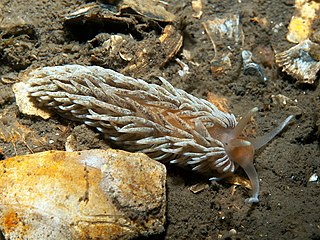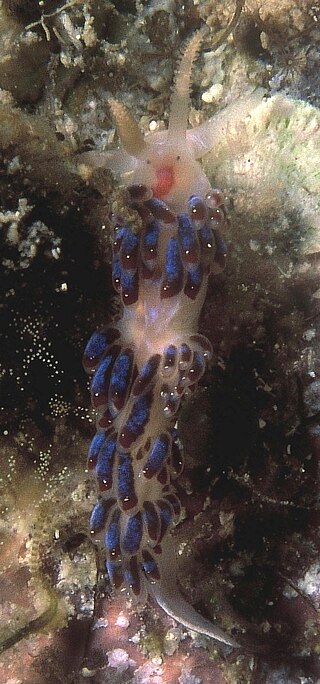
Rostanga is a genus of sea slugs in the family Discodorididae. Some sources, such as The Sea Slug Forum still classify Rostanga in the family Dorididae.

Aeolidiidae, a family of aeolid nudibranchs, are a family of sea slugs, shell-less marine gastropod molluscs.

Flabellina is a genus of sea slugs, specifically aeolid nudibranchs. These animals are marine gastropod molluscs in the family Flabellinidae.

Facelina rubrovittata is a species of sea slug, an aeolid nudibranch in the family Facelinidae.

Berghia coerulescens is a species of sea slug, a marine nudibranch in the family Aeolidiidae. It is the type species of the genus Berghia.

Aeolidiella is a genus of sea slugs, aeolid nudibranchs, marine gastropod molluscs in the family Aeolidiidae.

Facelina is a genus of sea slug, an aeolid nudibranch in the family Facelinidae.

Spurilla is a genus of sea slugs, aeolid nudibranchs, marine gastropod mollusks in the family Aeolidiidae.

Berghia is a genus of sea slugs, aeolid nudibranchs. They are shell-less marine gastropod molluscs in the family Aeolidiidae. They are covered in cerata which give them their unique tentacle look and color. Berghia are commonly found in shallow waters and their diet consists of strictly Aiptasia Anemone. This genus is now commonly used commercially to fight off Anemone populations in fish tanks.
Berghia rissodominguezi is a species of sea slug, an aeolid nudibranch. It is a shell-less marine gastropod mollusc in the family Aeolidiidae.

Berghia norvegica is a species of sea slug, an aeolid nudibranch. It is a shell-less marine gastropod mollusc in the family Aeolidiidae.
Berghia marcusi is a species of sea slug, an aeolid nudibranch. It is a shell-less marine gastropod mollusc in the family Aeolidiidae.
Berghia creutzbergi is a species of sea slug, an aeolid nudibranch. It is a shell-less marine gastropod mollusc in the family Aeolidiidae.
Berghia columbina is a species of sea slug, an aeolid nudibranch. It is a shell-less marine gastropod mollusc in the family Aeolidiidae.
Berghia dakariensis is a species of sea slug, an aeolid nudibranch. It is a shell-less marine gastropod mollusc in the family Aeolidiidae.
Berghia agari is a species of sea slug, an aeolid nudibranch. It is a shell-less marine gastropod mollusc in the family Aeolidiidae.
Eubranchus prietoi is a species of sea slug or nudibranch, a marine gastropod mollusc in the family Eubranchidae.
Spurilla braziliana is a species of sea slug, an aeolid nudibranch. It is a shell-less marine gastropod mollusc in the family Aeolidiidae.

Exaiptasia is a genus of sea anemone in the family Aiptasiidae, native to shallow waters in the temperate western Atlantic Ocean, the Caribbean Sea and the Gulf of Mexico. It is monotypic with a single species, Exaiptasia diaphana, and commonly known as the brown anemone, glass anemone, pale anemone, or simply as Aiptasia.
Berthella ocellata is a species of sea slug, a marine gastropod mollusc in the family Pleurobranchidae. It is native to the eastern Atlantic Ocean and the Mediterranean Sea where it inhabits the shallow sublittoral zone.









